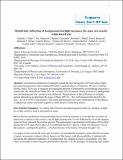Relativistic deflection of background starlight measures the mass of a nearby white dwarf star
Abstract
Gravitational deflection of starlight around the Sun during the 1919 total solar eclipse provided measurements that confirmed Einstein's general theory of relativity. We have used the Hubble Space Telescope to measure the analogous process of astrometric microlensing caused by a nearby star, the white dwarf Stein 2051 B. As Stein 2051 B passed closely in front of a background star, the background star's position was deflected. Measurement of this deflection at multiple epochs allowed us to determine the mass of Stein 2051 B - the sixth-nearest white dwarf to the Sun - as 0.675 ± 0.051 solar masses. This mass determination provides confirmation of the physics of degenerate matter and lends support to white dwarf evolutionary theory.
Citation
Sahu , K C , Anderson , J , Casertano , S , Bond , H E , Bergeron , P , Nelan , E P , Pueyo , L , Brown , T M , Bellini , A , Levay , Z G , Sokol , J , Dominik , M , Calamida , A , Kains , N & Livio , M 2017 , ' Relativistic deflection of background starlight measures the mass of a nearby white dwarf star ' , Science , vol. 356 , no. 6342 , pp. 1046-1050 . https://doi.org/10.1126/science.aal2879
Publication
Science
Status
Peer reviewed
ISSN
0036-8075Type
Journal article
Description
Based in part on observations made with the NASA/ESA Hubble Space Telescope, obtained at STScI, which is operated by the Association of Universities for Research in Astronomy, Inc., under NASA contract NAS 5-26555. HST data used in this paper are available from the Mikulski Archive for Space Telescopes at STScI (https://archive.stsci.edu/hst/search.php), under proposal ID 13457 and 14448. Support for this program was provided by NASA through a grant from STScI. The Pan-STARRS1 Surveys (PS1) have been made possible through contributions of the Institute for Astronomy, the University of Hawaii, the Pan-STARRS Project Office, the Max-Planck Society and its participating institutes, The Johns Hopkins University, Durham University, the University of Edinburgh, Queen's University Belfast, the Harvard-Smithsonian Center for Astrophysics, the Las Cumbres Observatory Global Telescope Network Incorporated, the National Central University of Taiwan, the Space Telescope Science Institute, NASA Administration under Grant No. NNX08AR22G, the National Science Foundation under Grant No. AST-1238877, the University of Maryland, and Eotvos Lorand University. MD thanks Qatar National Research Fund (QNRF) for support by grant NPRP 09-476-1-078.Collections
Items in the St Andrews Research Repository are protected by copyright, with all rights reserved, unless otherwise indicated.

